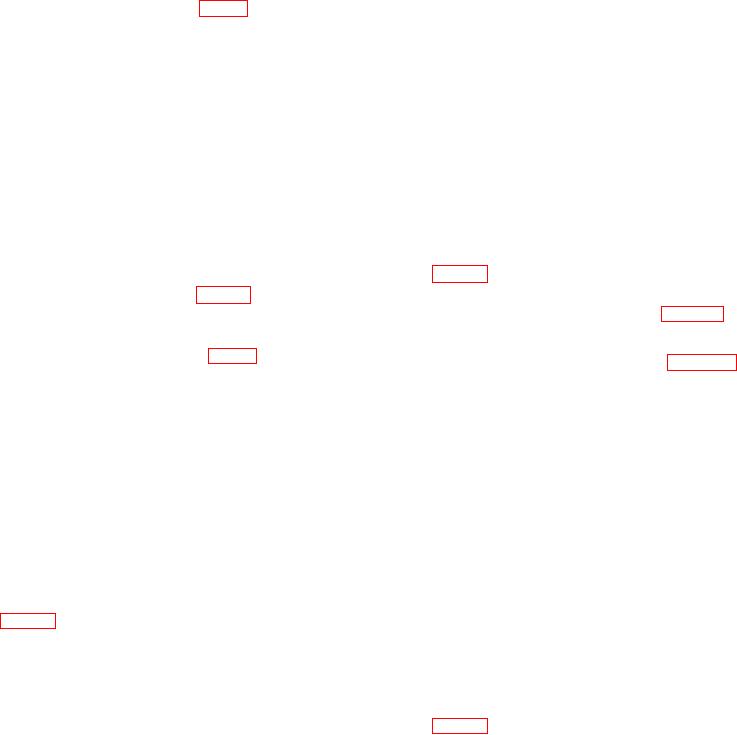
service periods. In extremely dusty operations, service
(5) Operate the engine and check for fuel
once or twice daily; in dust-protected areas, service the
leaks around the bowl.
air cleaner when changing oil.
b. Removal.
e. Governor. The governor (1, fig. 2) uses round
(1) Disconnect the two fuel lines ta the
steel balls as the motivating force producer, instead of
strainer.
masses of weight. When the governor is driven at
(2) Unscrew strainer from nipple at the fuel
increasing speeds by the engine through the governor
pump.
gear, the steel balls, moving outward, force the conical
c. Cleaning and Inspection.
upper race, fork base, and fork and lever assembly
(1) Clean all parts in an approved cleaning
toward a closed throttle position. An externally mounted
solvent; dry with clean, dry compressed
spring imposes tension on the lever assembly toward
air.
the open throttle position.
As the engine speed
(2) Inspect all parts for dents, cracked or
increases, the centrifugal force created by the balls
damaged parts, stripped threads, or other
increases until a balanced condition exists between the
defects. Replace damaged parts.
governor force and the spring force; the governing lever
remains stationary, holding a constant engine speed.
d. Installation Installation of the fuel strainer is the
.
The desired engine speed is obtained by increasing or
reverse of the removal procedure described in b above.
decreasing the governor spring tension.
58.
Fuel Pump
f. Fuel Primer Pump
.
A fuel primer pump,
mounted on the instrument panel (fig. 11), is provided
a. Service. Service the fuel pump sediment bowl
to pump fuel into intake manifold for cold weather
in the same manner as the fuel strainer (para 57.la).
starting.
b. Removal.
g. Fuel Tank. The fuel tank (6, fig. 2) is formed
(1) Remove the fuel strainer (para 57(1)b)
by metal sheets welded to the skids of the pumping unit.
and disconnect the two fuel lines at the
The tank is positioned approximately between the
fuel pump (3).
engine and centrifugal pump.
(2) Remove the two mounting nuts (4) and
lockwashers that secure the fuel pump to
h. Fuel Lines and Fitings. Fuel lines and fittings
t
the engine block; remove the fuel pump
carry fuel from the fuel tank to the fuel pump, and from
and gasket.
the fuel pump to the carburetor. A priming line extends
(3) Remove the fuel line fittings from the fuel
from the fuel pump to the primer pump, and a drain line
pump.
is connected to the carburetor.
c. Cleaning and Inspection.
i. Fuel Strainer A military approved fuel strainer
.
(1) Clean all parts in an approved cleaning
is installed just ahead of the fuel pump. Fuel from the
solvent; dry with clean, dry compressed
fuel tank is drawn through this strainer into the strainer
air.
section of the fuel pump.
(2) Inspect all parts for dents, cracked or
57.1. Fuel Strainer
damaged parts, stripped threads, or other
defects. Replace damaged parts.
a. Service.
d. Installation Installation of the fuel pump is the
.
(1) Close the fuel shutoff valve (1) Loosen
.
reverse of the removal procedure described in b.
the bail nut (12) and remove the sediment
above.
bowl (11), filter element, and gasket from
59.
Carburetor
the strainer.
(2) Clean the bowl and filter element with an
a. Adjustment.
approved cleaning solvent; dry with clean
compressed air.
(1) Adjust the carburetor with the engine at
(3) Replace the gasket, and replace the filter
operating temperature and in a level
element if clogged or distorted.
position, and with about one-half tank of
(4) Install the filter element, gasket and bowl
fuel.
on the strainer; secure by tightening the
(2) The main jet adjusting screw (10)
bail nut.
determines the amount of fuel which may
be obtained for high-speed operation. To
set this adjustment, open the throttle
TAGO 6358-A
28

